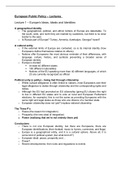Samenvatting
Summary European Public Policy Lecture Notes
- Instelling
- Haagse Hogeschool (HHS)
This documents contain all of the information shared in the lectures of the Course European Public Policy as well as pictures and extra information I found necessary to add. These Lectures give an overview of what can be discussed during the Exam and together with the book, provide a good knowledge...
[Meer zien]




